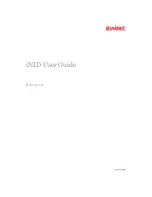
Telegesis (UK) Limited
TG-ETRXn-UG-01-103
18
User Guide
1.04
ETRX1 and ETRX2
©2008 Telegesis (UK) Ltd
ETRXn User Guide (Rev 1.04)
-14, -17, -20, -26, -43} Entering a value not on this list (such as
–19) will resulted in the next lowest
output power. Also on the ETRX2 specifying a power level of 4 will enable the boost mode
increasing both output power as well as sensitivity.
S03
This register contains the 128-bit encryption key. To learn more about security please refer to
chapter 8. Please note that a 128-bit number is represented by 32 hexadecimal characters. For
security reasons this register is write only and requires a password to be written to.
5.3 Module Setup (S04-S0A)
S04
This register contains a user readable name which can be up to 20 bytes long. This name has no
impact on the functionality and can be used to identify modules.
S05
In analogy to the user definable name this 16-bit register can be read and written by the user to
identify the module and has no impact on functionality. Writing to this register is password
protected as shown in the AT command dictionary.
S06
This is the main function register defining the behaviour of the module. Bits 0 to 4 and B define the
security mechanisms used for joining and maintaining networks as described in section 8. If bit 6
is set, the RSSI and LQI of the last hop will be displayed for all devices reporting in. If bit 8 is set
the local unit will become the network‟s data sink. Bits 9 and A define whether the unit is a RFD
(end device) and select whether it is a sleepy or a mobile sleepy end device. If bit C is set the user
will be prompted to accept a channel which has been requested by a remote node, if cleared the
channel will be accepted automatically. Setting bit D disables the possibility to have more than one
ucast or scast transmission in flight at any one time which might simplify host controller interaction.
Setting bit E enables multiple reads from remote S-
Registers using “ATSREM” at any one time.
For a more detailed description of these last two points please refer to the respective command
description in the AT command dictionary.
Finally, on the ETRX1 bit F should always read 0. If not please contact Telegesis. On the ETRX2
this bit is unused.
S07
In the extended function register many of the prompts which may show during operation can be
disabled to make interaction with a host microcontroller easier.
S08
This is the second extended function register allowing more prompts to be disabled. Furthermore
setting bit F makes changes to S02 take effect instantly as previously described. Setting bit E of
S08 to 1 enables I/O7 to indicate the power mode of the module by driving the pin high if in power
mode > 2 and driving it low otherwise. In order for this to work I/O7 must be defined to be an
output. Setting bit D activates a 1 second character timeout for xCASTB and channel operation.
Where this bit is set those commands will be aborted if no data is received on the local serial port
for more than 1 second. Finally setting bit C disables the mechanism causing a node to discard
and search for a new sink where three transmissions to the sink have failed.
S09
This register contains the password and therefore cannot be read remotely or locally. In order to
change a module‟s password you need to state the current password as shown in the command
dictionary.
















































